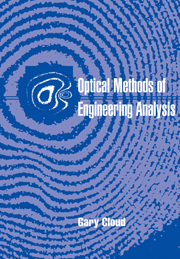Book contents
- Frontmatter
- Contents
- Acknowledgments
- 1 Introduction and orientation
- Part I Optics and interferometry
- Part II Photoelasticity
- Part III Geometrical moire
- Part IV Diffraction theory, optical processing, and moire
- Part V Moire interferometry
- Part VI Holographic interferometry
- Part VII Speckle methods
- 18 Laser speckle and combinations of speckle fields
- 19 Speckle photography
- 20 Speckle correlation interferometry
- 21 Electronic speckle pattern interferometry
- 22 Phase shifting to improve interferometry
- Author index
- Subject index
18 - Laser speckle and combinations of speckle fields
Published online by Cambridge University Press: 12 January 2010
- Frontmatter
- Contents
- Acknowledgments
- 1 Introduction and orientation
- Part I Optics and interferometry
- Part II Photoelasticity
- Part III Geometrical moire
- Part IV Diffraction theory, optical processing, and moire
- Part V Moire interferometry
- Part VI Holographic interferometry
- Part VII Speckle methods
- 18 Laser speckle and combinations of speckle fields
- 19 Speckle photography
- 20 Speckle correlation interferometry
- 21 Electronic speckle pattern interferometry
- 22 Phase shifting to improve interferometry
- Author index
- Subject index
Summary
Measurement methods based on the phenomenon known as coherent light speckle have become increasingly important in recent years. The development of electronic speckle pattern interferometry, in which the speckle patterns are acquired by a television system and then combined in a computer to create fringe patterns that can be displayed on a television monitor, has generated additional interest in speckle methods.
This chapter discusses the origins and nature of laser speckle, and it then goes on to describe the product of combining speckle fields in different ways. These notions are important to understanding the various methods by which speckle is employed in interferometry, as are described in subsequent chapters. Given the importance of electronic speckle techniques, the development assumes, where appropriate, that the recording of speckle irradiance is by means of an electronic detector rather than by a photographic emulsion.
Most of the concepts in this chapter have been treated exhaustively, lucidly, and creatively by Ennos (1975), Goodman (1975), Jones and Wykes (1983), and Vest (1979). The exposition that follows is synthesized primarily from these references, particularly the first three. In some cases, the words follow closely those of the the authors; their descriptions have become accepted as the classical standards. The references mentioned also carry extensive and useful bibliograpies.
The speckle effect
The invention of the laser created great anticipation among users of optics because it appeared to be the answer to a great many illumination problems. Here was a source that produced a beam of light that was intense, collimated, narrow, monochromatic, and coherent. Disappointment soon followed.
- Type
- Chapter
- Information
- Optical Methods of Engineering Analysis , pp. 395 - 408Publisher: Cambridge University PressPrint publication year: 1995
- 6
- Cited by

